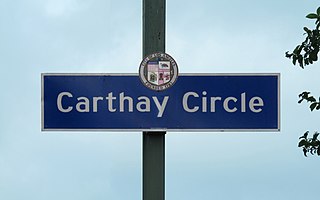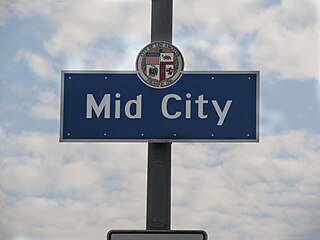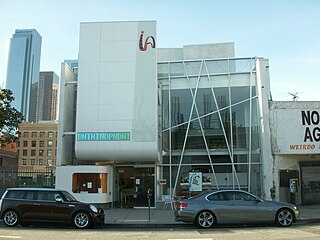
Fox Theatres was a large chain of movie theaters in the United States dating from the 1920s either built by Fox Film studio owner William Fox, or subsequently merged in 1929 by Fox with the West Coast Theatres chain, to form the Fox West Coast Theatres chain. Fox West Coast went into bankruptcy and was sold to The National Theatres Corporation, led by Charles Skouras, on November 19, 1934, for $17,000,000.00. Eugene Klein later became CEO of National, and turned it into the conglomerate National General. Mann Theatres bought National General's theatres in 1973.
Landmark Theatres is a movie theatre chain founded in 1974 in the United States. It was formerly dedicated to exhibiting and marketing independent and foreign films. Landmark consists of 34 theatres with 176 screens in 24 markets. It is known for both its historic and newer, more modern theatres. Helmed by its President, Kevin Holloway, Landmark Theatres is part of Cohen Media Group.
Picfair Village is a neighborhood in the Central area of the city of Los Angeles, California.

Carthay Circle is a neighborhood in the Mid-City West region of Central Los Angeles, California. Originally named Carthay Center, the neighborhood was later renamed after the famed Carthay Circle Theatre.

The Warner Grand Theatre is a historic movie palace that opened on January 20, 1931. It is located in San Pedro, Los Angeles, California, at 478 West 6th Street.

The Alex Theatre is a landmark located at 216 North Brand Boulevard in Glendale, California, United States. It is currently owned by the city of Glendale and operated by SAS. The theater's capacity is 1,400.

Faircrest Heights is a neighborhood in Mid-City, Los Angeles, California.

Mid City is a neighborhood in Central Los Angeles, California.
ArcLight Cinemas was an American movie theater chain that operated from 2002 to 2021. It was owned by The Decurion Corporation, which was also the parent company of Pacific Theatres. The ArcLight chain opened in 2002 as a single theater, the ArcLight Hollywood in Hollywood, Los Angeles, and later expanded to eleven locations in California, Massachusetts, Maryland, and Illinois.

The Downtown Independent was a one screen theater and cinema located at 251 S. Main Street in the Little Tokyo area of Los Angeles, California. It was operated by the Downtown Independent and owned by Orange County, California's Cinema Properties Group. The venue is slightly less than 10,000 square feet (930 m2) and had stadium seating for 222.
Pacific Theatres was an American chain of movie theaters in the Los Angeles metropolitan area of California. Pacific Theatres was owned by The Decurion Corporation which also owned and operated ArcLight Cinemas. In 2008, it sold its store locations in San Diego to Reading Cinemas. In April 2021, Pacific Theatres announced they would not be reopening any of their theater locations after being closed since March 2020 due to the COVID-19 pandemic. In June 2021, the company filed for Chapter 7 bankruptcy. Following the closure, some former Pacific locations were acquired by AMC Theatres.
S. Charles Lee was an American architect recognized as one of the most prolific and distinguished motion picture theater designers on the West Coast.
The Pussycat Theaters were a chain of adult movie theaters, operating between the 1960s and the 1980s. Pussycat Theaters had 30 locations in California and were known for their cat-girl logo. The last one closed in 2022.

Reid & Reid, also known as Reid Brothers, was an American architectural and engineering firm that was active from 1880 to 1932. Established in Indiana by Canadian immigrants, the firm moved to the West Coast and became was the most prominent firm in San Francisco, California in the late 19th and early 20th centuries.

The Hayworth Theatre is a theater and performing arts venue at 2511 Wilshire Boulevard located in the Westlake neighborhood of Los Angeles, California.

Leroy Charles Griffith is an American theater and nightclub proprietor, former Broadway theater producer, and burlesque and film producer. In a career spanning 75 years, he has owned, leased, or operated more than 70 stage and cinematic theaters across the United States, dating from the burlesque era of the 1950s to the present day.
Henry Holdsby Simmonds sailed for Canada at the 1932 Summer Olympics in Los Angeles, US. He subsequently became an architect who specialized in neighbourhood movie theatres. His Odeon Theatre in Victoria, British Columbia is on the Canadian National Register of Historic Places. He is also known for designing industrial facilities and apartment buildings. Most of his projects were in the Vancouver area.

The State Theatre, formerly known as Loew's State Theatre, at 703 S. Broadway, is a historic movie theatre which opened in November 1921 in the Broadway Theatre District of Downtown Los Angeles.
Clarence Justin Smale, also known as C.J. Smale, was an American architect.
Benjamin Schlanger was an American theater architect. Some of the theaters he designed include: the Jewel Theater at 711 Kings Highway, Brooklyn, City Cinemas I-II, the Vistavision Todd-AO Patriot Theaters at Colonial Williamsburg, Grade Arts Center, the Leonard Nimoy Thalia Theater, at Symphony Space and the Waldo Theatre. He received a Certificate of Merit from the Municipal Art Society with co-designer Abraham W. Geller for Cinema I-II. He also played a key design role in: the United Nations General Assembly Building and the Metropolitan Opera House in the Lincoln Center for the Performing Arts as well as the Place des Arts, the Sydney Opera House and the John F. Kennedy Center. He chaired the Committee on Auditorium and Theater Architecture of the American Institute of Architects and was a trustee of the National Institute of Architectural Education. In addition, he was a contributor to The Architectural Forum and The Architectural Record and in 1964 was the recipient of the Albert S. Bard architectural award.











